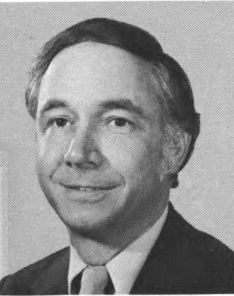Bill Gradison facts for kids
Quick facts for kids
Bill Gradison
|
|
|---|---|
 |
|
| Member of the U.S. House of Representatives from Ohio |
|
| In office January 3, 1975 – January 31, 1993 |
|
| Preceded by | Tom Luken |
| Succeeded by | Rob Portman |
| Constituency | 1st district (1975–1983) 2nd district (1983–1993) |
| Mayor of Cincinnati | |
| In office 1971 |
|
| Preceded by | Eugene P. Ruehlmann |
| Succeeded by | Tom Luken |
| Personal details | |
| Born |
Willis David Gradison Jr.
December 28, 1928 Cincinnati, Ohio, U.S. |
| Political party | Republican |
| Education | Yale University (BA) Harvard University (MBA, DCS) |
Willis David "Bill" Gradison Jr. (born December 28, 1928) is an American politician from Ohio. He served in the United States House of Representatives, which is part of the U.S. Congress, from 1975 to 1993.
Contents
Early Life and Education
Bill Gradison was born in Cincinnati, Ohio. He went to Walnut Hills High School. After high school, he studied at Yale University, where he earned a Bachelor of Arts degree in 1949. He continued his education at Harvard University, getting a master's degree in business in 1951 and a special doctorate in commercial science in 1954.
Career in Public Service
Bill Gradison started his career working as an investment broker. He then held important roles in the government. From 1953 to 1955, he was an assistant to a top official in the U.S. Treasury Department. After that, from 1955 to 1957, he worked as an assistant to the Secretary of Health, Education, and Welfare.
Serving Cincinnati
Gradison was elected to the Cincinnati city council, where he served for many years, from 1961 to 1974. During this time, he also served as the Mayor of Cincinnati in 1971. At that time, the role of mayor rotated among the council members.
Joining the U.S. Congress
In 1974, Bill Gradison was elected to the United States House of Representatives. He started serving in Congress in 1975. He was the first Jewish person from Ohio to be elected to the U.S. Congress. He first represented Ohio's 1st district. After the 1980 census, his district was renumbered as the 2nd district. He continued to serve in Congress until 1993. He left Congress to become the president of the Health Insurance Association of America.
Important Tax Laws in the 1980s
During the 1980s, Bill Gradison was a member of the U.S. House Ways and Means Committee. This committee works on tax laws and other important financial matters. He helped create several important laws, including major tax acts in 1981, 1984, and 1986, and a Social Security law in 1983.
The Economic Recovery Tax Act of 1981
Bill Gradison played a key role in the Economic Recovery Tax Act of 1981. He suggested a rule that would automatically adjust income tax brackets for inflation. This meant that people's income tax rates wouldn't go up just because of inflation, which is called "bracket creep." This idea was very popular and was included in President Reagan's tax reduction bill.
The bill, known as the Conable-Hance Substitute Tax Bill, became law. It included a 25 percent tax cut over three years, along with other tax relief and the inflation adjustment for tax rates.
Social Security Reform Act of 1983
Gradison also worked on changes to the Social Security system. He was the top Republican on the Ways and Means Subcommittee that focused on Social Security. He helped pass the Social Security Reform Act of 1983.
He proposed two important ideas that became part of this law. One idea was to use computers to track death certificates of Social Security recipients. This helped prevent payments from going to people who had already passed away. Another idea was to keep the Social Security Trust Funds separate from the general government budget. This was done to make sure decisions about Social Security were not influenced by politics.
Tax Reform Act of 1984
Bill Gradison was also involved in the Tax Reform Act of 1984. He proposed a bill that helped clarify how certain employee benefits, called "fringe benefits," should be taxed. Before this, there was a lot of confusion, and Congress had even stopped the IRS from making rules about these benefits. Gradison's bill helped make it clear which fringe benefits should be taxed and which should be exempt.
Tax Reform Act of 1986
Gradison also contributed to the tax reform efforts in 1986. He asked for a study to see how much corporate tax rates could be lowered if a certain tax credit (the 10% investment tax credit) was removed. The study showed that the top corporate tax rate could drop from 46% to 39% without changing the total amount of tax money collected. This idea was included in the final Tax Reform Act of 1986, which lowered the top corporate tax rate to 34%.
After Congress
After leaving Congress in 1993, Bill Gradison continued to serve in important roles. Rob Portman was elected to fill the House seat that Gradison left.
In 2002, Gradison was appointed to be a founding member of the Public Company Accounting Oversight Board (PCAOB). This board was created to oversee the audits of public companies. He was reappointed in 2004 and served as Acting Chairman for a period. He remained a PCAOB Board member until 2011.
He also served as a commissioner for the Medicare Payment Advisory Commission (MedPAC) for six years. MedPAC is an independent agency that advises the U.S. Congress on issues related to the Medicare program, which helps with healthcare costs for older Americans.
As of 2022, Bill Gradison serves on the board of directors for the Committee for a Responsible Federal Budget.
See also
- List of Jewish members of the United States Congress
- List of United States representatives from Ohio

